
Barely a year after the launch of the X-Pro1, Fujifilm introduces a second model. Our test will show whether this is its “little sister” or biggest rival. The Fujifilm X-Pro1 was one of the most acclaimed cameras of the year. Trimmed down externally to look retro, the newly developed X-Trans sensor outclasses the APS-C competition: excellent sharpness, pleasing “analog” color reproduction and the ability to simulate preceding Fujifilm films make this camera a much sought-after object for many photographers. How does the new X-E1 fare in comparison? In order to come to the point: this camera is pure bliss.
With the X-E1, Fujifilm rounds off the lower end of its X series range. It comes without the complex, hybrid viewfinder of the X-Pro1. This makes the camera not only lighter but also less expensive. However, it is equipped with exactly the same X-Trans sensor that is found in the X-Pro1 and has the same brain and guts. The picture quality of the two cameras is therefore exactly the same.
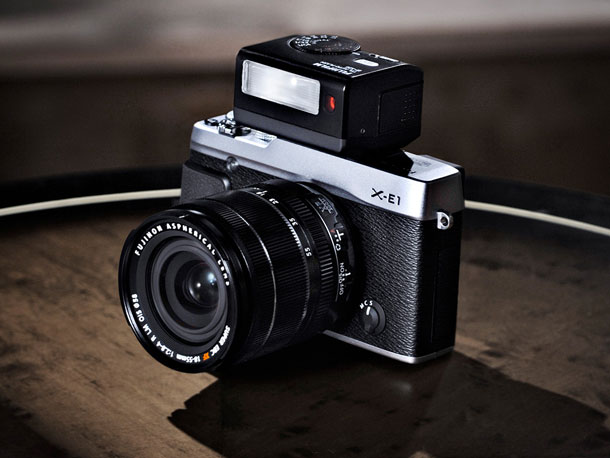
By the way: Although this is a test and not a comparison, measuring the X-E1 against the X-Pro1 is unavoidable. We will conclude by discussing which target group is best served by which camera.
The Dreary Specifications
The X-Trans sensor has a resolution of 16MP. Its unique feature is the unconventional color filter configuration which is divided into 6×6 pixel units. As a result, RGB color information is included in each sensor row which significantly improves color reproduction. However, precisely this arrangement makes high demands on the RAW conversion, as we shall see later.
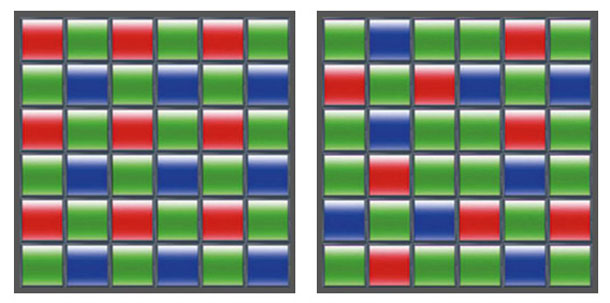
This new matrix is based on randomly distributed grain of analog films. The pseudo-irregular distribution on the sensor prevents moiré formation in geometric patterns, as might be found in garments, for example. Consequently, the Fujifilm engineers eliminated use of an upstream low-pass filter which reduces interference with slight blurring. This results in significantly sharper images.
The Casing
The body is made of magnesium alloy and is available in silver and black. The material provides the appropriate haptics and a feeling of high quality. In size the X-E1 would fit into a large-ish coat pocket, but the camera with its 540 grams (including the 35mm lens) is extremely light.
In contrast to the X-Pro1, the X-E1 is fitted with an electronic viewfinder which significantly reduces size and weight. The body alone weighs 350 grams (including battery and card), 100 grams less than the X-Pro1. Eliminating the electronic viewfinder means, however, that the X-E1 is not a rangefinder camera like her big sister but a mirrorless system camera, as the Sony NEX range or the Olympus OM-D E-M5.
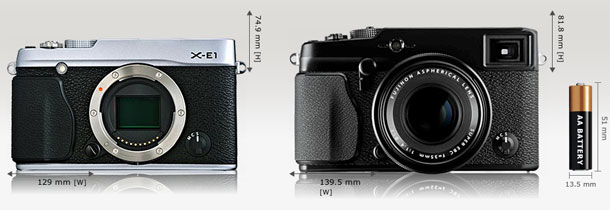
The Viewfinder
The electronic viewfinder has a 2.36MP resolution and provides outstanding, high contrast images. All effects, settings and depth of focus are displayed before exposure. The high frame rate ensures that virtually no delays or stuttering are experienced.
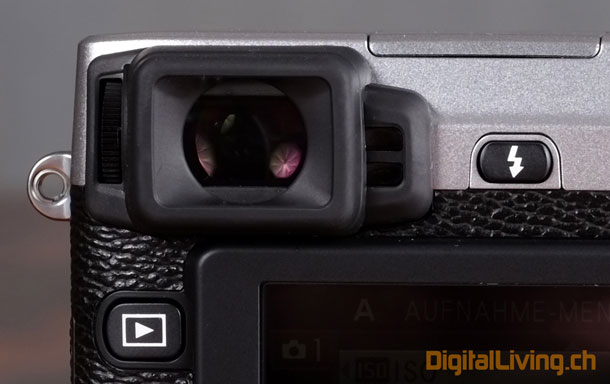
To the left of the viewfinder is a dial that can be used to correct vision impairment between -4 and +2 dioptre. Unfortunately, it is not marked at all, not even the “0” is indicated. Call it minimalism in action. To the right of the viewfinder are the proximity sensors which automatically switch from display to viewfinder when the photographer holds the camera to his face. The indicators in the viewfinder can be assembled individually enabling you to display the information relevant to you personally.
Good news for fans of polarizing sunglasses: The image in the viewfinder is visible in both portrait and landscape formats (with the X-Pro1, the viewfinder turns pitch-black).
Mechanical Controls
The operation of the X-E1 is pure bliss. Mechanically, it brings back everything that was taken from us in the course of digitization. It is assumed that the X series is directed at photographers who “know their craft.” That’s not correct. Those who understand the basic relationship between aperture, shutter speed and exposure compensation will be delighted with the mechanical controls from the start. That’s a promise.
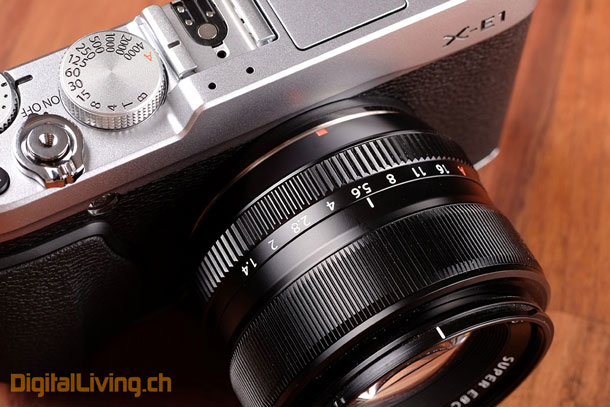
Both the aperture ring and shutter speed are equipped with the position “A.” When both As are activated, the program runs automatically, if not either shutter speed or aperture have priority. If both automatics are out of play, exposure is controlled manually. All very simple.
In contrast to the X-Pro1, a locking button which is depressed to release the shutter speed from the “A” position is missing in the X-E1. That’s good news because, in practice, it is almost impossible to turn these dials accidentally — in stark contrast to the exposure compensation button.
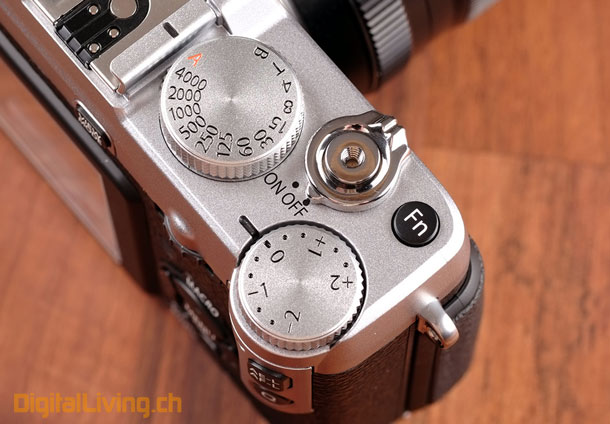
There’s a subtle change in the remote release. The X-E1 features an electronic remote release along with the mechanical release. Fujifilm provides the RR-80 which is connected via USB port. The new microphone port can, in turn, be fitted with remote triggers that are compatible with Pentax and Canon cameras. As the remote trigger was missing we were unable to test it.
The Q Menu
In addition to the conventional menu in list form, the “Q” menu displays the 16 most important features on a grid. It is operated by a dedicated button via D-pad and dial.
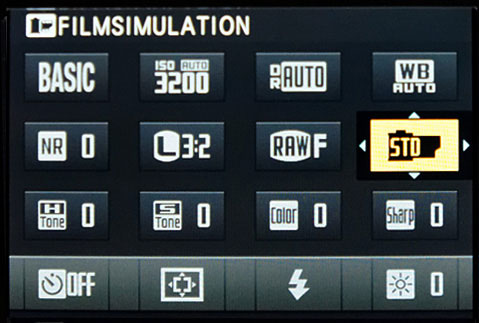
Its operation can be mastered very quickly because it is so easy to note the position of a shot. Film simulation? Just stay on the right, then take the second row from the top. Quite unlike the usual interminably long menus you have to scroll through for every change. The most commonly used command is also on the Fn key and is always at your fingertips.
Practical Experience
In the field, the X-E1 scores well with its modest dimensions and the accessible, easy grip controls. The aperture ring is in exactly the right place, the small rubber grip on the right fits the hand well.
Tip: The supplied camera strap is very basic. If you don’t shy away from extra costs, treat yourself to the “Street Strap” which not only consists of very attractive, skin-friendly material, it also matches the X-E1 perfectly. For maximum freedom of movement just wrap the Street Strap twice around your wrist and nothing can go wrong.
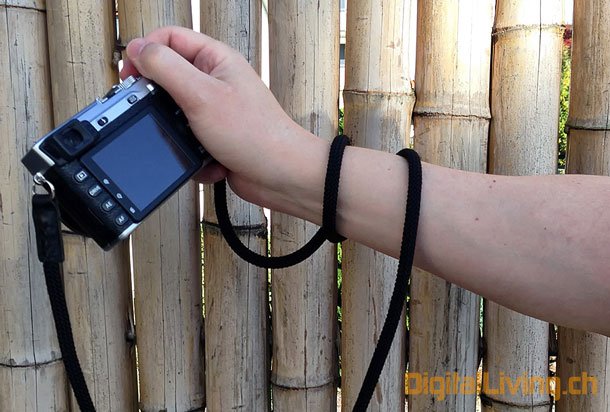
Take It Easy!
As with the X-Pro1, the autofocus of the X-E1 is not the fastest in the trade. If you’ve been using the Nikon or Canon DSLR the difference will be apparent. The speed is sufficient for regular snapshots. However, capturing children or dogs at play needs a little more experience — accompanied by a bit of good luck.
This slight shortcoming relates only to speed. Once the focus is found the E-X1 it provides razor-sharp images. If your first thought is, “I can live with that,” then you will find the autofocus of the camera satisfactory. If, however, action photography is your specialty, look for a different camera.
Making Films
The X-E1 films in full HD. That sounds good, but actually you are always aware that moving images do not enjoy high priority. The maximum frame rate is 24 fps and a dedicated film button is nowhere to be found. The quickest way forward is by using the freely assignable Fn key — if you are willing to sacrifice it for this function.
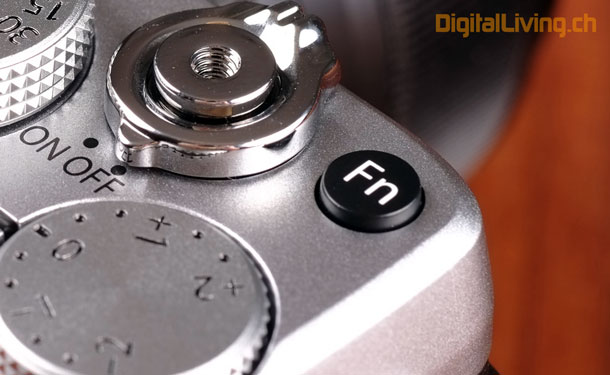
Do not expect as much from the X-E1 as from other high-end cameras, even if the film function has been slightly upgraded since the X-Pro1. The camera now has a stereo microphone on the top panel and a 2.5mm jack to connect an external microphone.
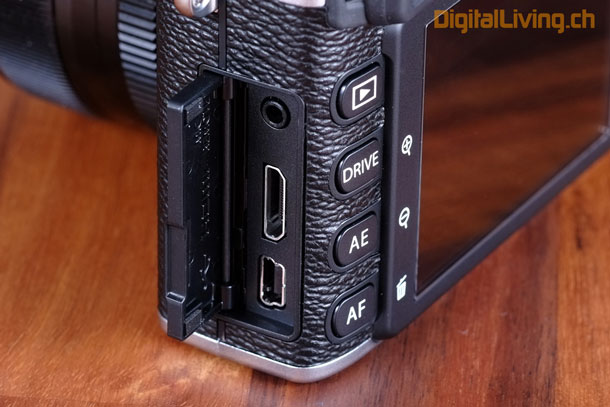
Capture Modes
The X-E1 offers single shots and sequence shooting with 3 or 6 fps. A panorama function automatically shoots a series of pictures and then puts them together on a widescreen. Bracketing is possible as well in which ISO, exposure, film simulation and dynamics are delivered in three variants.
Auto bracketing is not used to its full potential, unfortunately. It shoots three images with a maximum deviation of plus or minus an aperture — definitely not enough for HDR photography. But there is the hope that Fujifilm will follow up with new firmware.
The Tailor-Made Camera
The photographer can customize every single detail of “his” X-E1. This includes not only the configurable displays in the viewfinder but also the characteristics of the images, such as sharpness, contrast, saturation, etc. In addition, the camera offers up to 7 memory slots to store different settings for later retrieval. It is, however, inexplicable why the settings can not be labeled.
The Flash
The built-in flash that complements the hot shoe deserves our special attention. Its tiny size makes it unsuitable to illuminate a whole scene but is sufficient to lighten shadows in bright sunlight. Shutter speed position “A” synchronizes the X-E1 with just 1/180th of a second, but one can also flash with a manually selected 1/250th of a second.
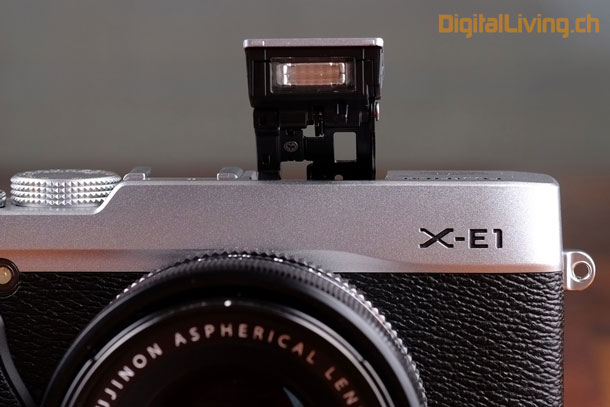
The built-in flash is a very welcome addition, because in Commander mode it can be used as a commander for flash equipment! Using the flash then triggers the studio installation preventing the noxious little light bulb from meddling with the exposure.
That will get some envious glances from X-Pro1-owners, because their camera does not by any means work with every remote trigger. The X-Pro1 cannot act as commander even with a system flash.
RAW Processing
One of the X-E1’s weak points is the RAW processing. Fujifilm provides the camera with only the most rudimentary program, MyFinePix Studio — a way too simple image management program which is available only for Windows. Forget it. The other software is called “RAW File Converter EX” and is one of the 50 ugliest programs that has been developed since the invention of the transistor.
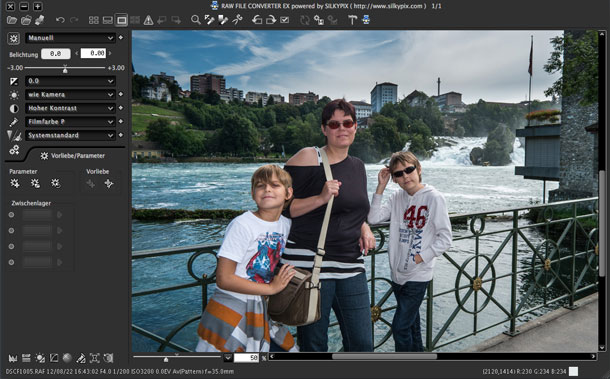
The RAW converter (version 3) is included for both Mac and Windows and comes from Silkypix. An X-E1 buyer has the dubious pleasure of acquiring a discounted upgrade to version 5. You should try this RAW converter at least once to prove to yourself that an alternative must be found at any cost.
Alternative RAW Converter Sought
But that’s not found that easily. The X-Trans sensor causes most software vendors a headache — or they are just not willing to invest a lot of work in a relatively small target group. There is only one viable alternative RAW converter:
Adobe Lightroom (4.2) respectively Photoshop (CS6) with Camera RAW 7.2 (that will elicit a loud “Whew!” from many photographers). However, the full version of Lightroom 4 costs just as much as the Silkypix converter update.
But then the sky darkens. Apple (Aperture), DxO (Optics Pro) and Phase One (Capture One) do not address this issue. None of the manufacturers will specify whether and when the X-Trans sensor will be supported. In short: If you buy the Fujifilm X-E1 you have keep in mind that there may never be a viable alternative to Adobe Lightroom / Camera RAW — and an orderly workflow with Optics Pro or Capture One will not come about soon.
Image Quality
The RAW issue takes a backseat once you see the first JPEGs from the camera on the screen. The quality can only be adequately described when you delve deep into the box of superlatives. The sharpness fluctuates between “fantastic” and “incredible” (tested with the 35mm lens). If you like pixel peeping, look forward to many happy hours in front of the monitor.
The enthusiasm about the picture quality is fueled further when you start playing through the built-in film simulation. The X-E1 default settings provide soft, delicate and almost boringly neutral images based on the color of the Fujifilm Provia. However, the values can be adjusted for contrast, saturation and more, so you can develop your own style.
In addition, the X-E1 simulates nine other film types. These include Fujifilm films such as the colorful Velvia and the soft Astia, not to forget a black-and-white conversion that is optionally supplemented by simulated yellow, red or green filters.
These film simulations ensure that the images are reminiscent of analog photographs — with the exception of lack of grain. With most other cameras this atmosphere can only be achieved by post-processing.

Anyone looking for his own style in JPEG pictures will have an easy ride. You simply take a photo in RAW format and develop it differently in the camera because film simulation and all other settings can be applied retrospectively. The X-E1 stores the results as JPEGs in the camera, so you can compare them later on the computer.
Twilight Shots
Even at ISO 6,400 the noise is kept within narrow limits, so the flash can stay in the bag in shallow light. If preferred, the sensitivity setting can be taken over by auto ISO which works between 400 and 6,400. If sensitivity is set manually, ISO values between 100 and 25,600 can be selected, but only in JPEG format. In RAW format the range of values decreases to between ISO 200 and 6,400.
Unfortunately, Fujifilm still has not managed to extend auto ISO for the X-E1 so as to allow for the longest shutter speed. If it is left to the camera, the ISO auto chooses shutter speeds that are too slow resulting in blurred images. It is to be hoped that a firmware update for this ordinary function will follow soon.
What Are We missing?
With regard to its photographic qualities, the X-E1 leaves nothing to be desired (apart from the somewhat botched auto ISO). But although this camera has stripped photography down to its core, we would have liked a few more technical frills.
The substantial film feature will annoy the occasional family photographer — the under-motorization is even more infuriating because 30 fps full HD movies in all price ranges are now standard, even for no-name smartphones. Film fans will be compelled to take an additional camera or camcorder with them on holiday. A folding display for use when shooting close to the ground or over a crowd would also be desirable — because the X-E1 is predestined for reporting. And a GPS module for automatic Geotagging would not spoil the retro idea. However, this criticism is purely subjective.
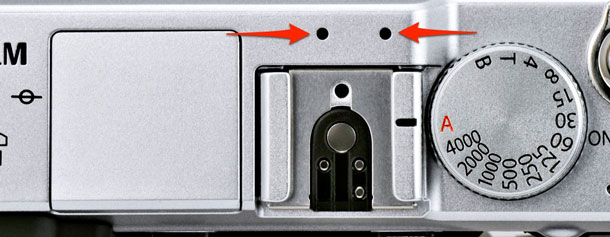
Fujifilm has proved in the past that support for existing models is taken seriously. Many of the X-Pro1’s shortcomings were rectified with firmware updates, right through to the speed of the autofocus. We are confident that the X-E1 will be improved over time and small annoyances, like auto ISO, will be corrected.
X-E1 vs. X-Pro1
The question that interests both existing X-Pro1 owners as well as potential buyers is: how does the X-E1 stand up against the significantly more expensive and heavier X-Pro1?
This question will soon generate fuel for conflict and many red heads in forums in the near future. The answers depend on personal preferences. The following recommendation should therefore be viewed with caution.
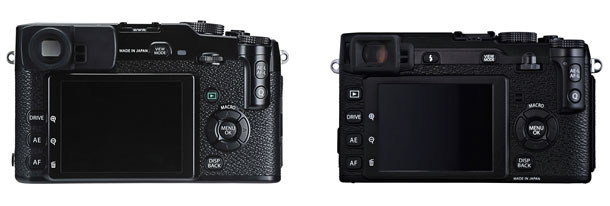
X-Pro1: The X-Pro1 could be typified as the “rangefinder camera.” It is designed to make street photographers happy in every respect. The optical viewfinder, size, appearance and, last but not least, the aura of this camera meet the needs of this target group perfectly. The X-Pro1 is a dream for anyone unwilling to spend an absurd amount of money on a Leica M series rangefinder — but wants comparable image quality.
X-E1: The X-E1, however, outdoes the X-Pro1 in every respect, apart from the missing hybrid viewfinder. It is lighter, less expensive and more compact. It is has a built-in flash which can be used to control a studio flash system. There are also small improvements such as the built-in dioptre correction and the microphone input. Most importantly, these have been integrated without sacrificing the phenomenal image quality.
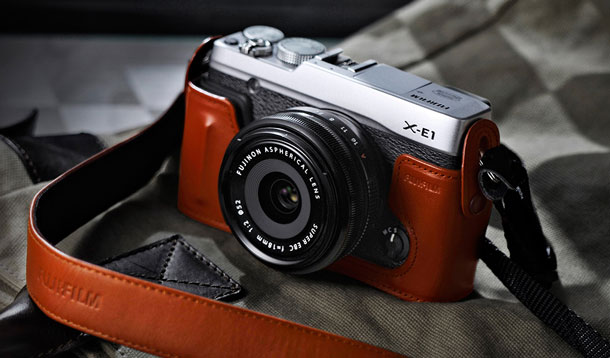
Short and to the point: Anyone using the X-Pro1 must want its unique hybrid viewfinder — really desperately. That said, the X-E1 presents itself as the better camera at a significantly lower price.
Target Group
The target group of the X-E1 is quickly identified: this camera was created for reporting, landscape photography, street photography and family portraits. It is aimed at people who celebrate photography but are not looking for a camcorder replacement. Sports photographers will definitely not be happy with it because, firstly, the lenses are missing and, secondly, the autofocus is not up to scratch.
Bottom line: The Fujifilm X-E1 provides not only excellent image quality but transforms photography into pure enjoyment. The excellent ergonomics, mechanical controls and discreet, but high quality appearance speak a clear language. Weight and dimensions have been reduced so that it can compete easily with the mirrorless competition. If you can live with minor drawbacks, you will own a camera that leaves nothing to be desired.
+++ Order the Fujifilm X-E1 from Amazon (black/silver), B&H (black/silver) or Adorama (black/silver). We recommend you use the best available glass, so go for the 35mm F1.4. For the latest X-E1 reviews and hands-on reports, don’t miss our dedicated, continuously updated The Fujifilm X-E1 File.


